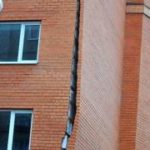Reasons for insulating the foundation. Two major approaches for foundation insulation. Technical nuances of exterior insulation.
At first glance, the foundation doesn’t need insulation as it is located below ground level. What is the purpose of foundation insulation when you have got an unheated basement? – The answer is, to prevent heat losses in the house basement. Such insulation will not only help prevent heat loss through the basement, but will protect the house from formation of condensation and increase of moisture and mold on the basement walls.
Do I choose interior or exterior insulation?
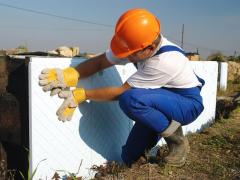 It is considered that the most reasonable way of foundation insulation is coating the walls from outside. There is a good reason for that.
It is considered that the most reasonable way of foundation insulation is coating the walls from outside. There is a good reason for that.
- Irrespective of the insulation type used and the kind of foundation, exterior insulation allows protecting the foundation from frost, preventing the impact of low temperatures on the inner side of the building.
- External insulation has quite a positive influence on the concrete quality as well as on the foundation structure, maintaining strength of the design for years.
- Also, the outer insulation serves as an additional impediment to groundwater which helps protect the waterproofing from moisture impact.
- Along with the bottom part of the foundation structure the exterior insulation coating resists temperature changes which happen in the upside of any basement during the offseason.
- But in particular situations the external foundation insulation is impossible. Then you have to resort to internal insulation. This method still has got some advantages.
- Thermal insulation inside the basement has a positive influence on the general condition of the house on the whole and on the cellar in particular.
- Internal insulation prevents penetration of groundwater.
- Internal insulation stops condensation accumulation in the basement.
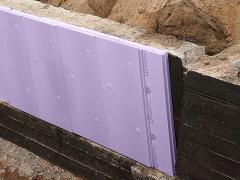 Internal insulation is still incapable to prevent freezing of the foundation walls from outside. Due to changes in temperature and frost heave of the ground deformation occurs and the foundation cracks all around the perimeter.
Internal insulation is still incapable to prevent freezing of the foundation walls from outside. Due to changes in temperature and frost heave of the ground deformation occurs and the foundation cracks all around the perimeter.
If you make up your mind to hold insulating of the foundation from the inside, it seems you do have a reason for that. Polyurethane foam is the most suitable material for insulation of the basement surface or sub-floor inside, since it is much more convenient to work with in a limited space and it takes little time.
The process of insulation is very simple – you need to spray polyurethane foam throughout the inner area of the foundation, partially involving the basement walls. In a similar manner you can perform insulation of the ceiling and floor. Thus, you will definitely protect the basement from the cold and moisture. But then you ought to finish the walls along with the ceiling and floor.
How to attach thermal insulation on the outside of the foundation
Most appropriate insulating materials here are the foam plastic, polyurethane foam and polystyrene foam. The latter can be applied in a similar manner as in the interior insulation of the basement, but before spraying polyurethane foam, you have to do some preparatory work to expose the bottom area of the house foundation.
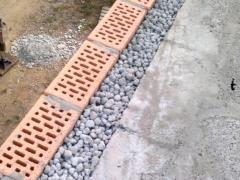 An operational method is to install polystyrene foam insulation. To insulate the foundation with foam plastic or polystyrene foam you have to release the area around foundation from the dirt. To do this, dig a trench with depth equal to that of foundation and width of 16-20 inches. Then the wall’s surface is carefully trimmed from the ground remains and leveled.
An operational method is to install polystyrene foam insulation. To insulate the foundation with foam plastic or polystyrene foam you have to release the area around foundation from the dirt. To do this, dig a trench with depth equal to that of foundation and width of 16-20 inches. Then the wall’s surface is carefully trimmed from the ground remains and leveled.
Next, the waterproofing is applied on clear, dry walls. Installing of the insulation can be made no earlier than in 5-7 days after accomplishing of waterproofing. It is a time needed for complete evaporation of the solvent, which may be contained in the waterproofing composition.
Further, foundation insulation panels are attached with special adhesive solution or bitumen mastic. The junctions between the panels are filled with foam.
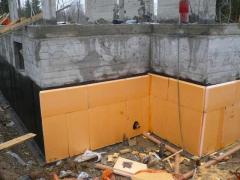 Note: the upper panels of insulation should exceed the ground level by 16 inches – this will preserve the foundation structure and walls from the possible rise of groundwater. After all the work on adhering the sheets of polystyrene foam or plastic foam is completed, the insulation can be plastered over through the grid.
Note: the upper panels of insulation should exceed the ground level by 16 inches – this will preserve the foundation structure and walls from the possible rise of groundwater. After all the work on adhering the sheets of polystyrene foam or plastic foam is completed, the insulation can be plastered over through the grid.
Then you can start filling the trench. Its bottom is covered with a coat of sand (4-5 in), then you may put a piece of insulation, after that you put a layer of gravel (24-28 in), and then proceed to pouring concrete, filling in the sand or rolling up the asphalt. As an alternative, decorate the surface with stone or tiles.
Providing insulation using ceramsite
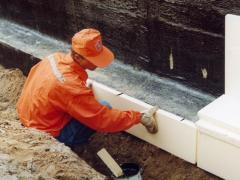 Another way of insulating the basement from the outside is the application of ceramsite. However, this method has partially gone into oblivion due to its high cost and low efficiency, although previously it had been used a lot. The process of insulating the foundation with ceramsite in many aspects is similar to the insulation with foam plastic. You need to dig 3 ft wide trench with a depth corresponding to that of the foundation. Waterproofing material is laid at the bottom and the entire trench is filled with ceramsite granules. The layer must be thick enough, as ceramsite has poor thermal insulation properties. Over the ceramsite you need to lay the roofing felt, pour sand or ground.
Another way of insulating the basement from the outside is the application of ceramsite. However, this method has partially gone into oblivion due to its high cost and low efficiency, although previously it had been used a lot. The process of insulating the foundation with ceramsite in many aspects is similar to the insulation with foam plastic. You need to dig 3 ft wide trench with a depth corresponding to that of the foundation. Waterproofing material is laid at the bottom and the entire trench is filled with ceramsite granules. The layer must be thick enough, as ceramsite has poor thermal insulation properties. Over the ceramsite you need to lay the roofing felt, pour sand or ground.
